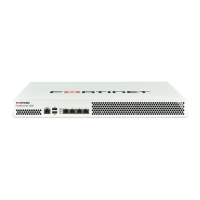System monitoring Page 89 FortiRecorder 2.4.2 Administration Guide
5. Click OK.
Community
Hosts
IP Address Type the IP address of the SNMP manager that, if traps or queries are
enabled in this community:
• will receive traps from the FortiRecorder appliance
• will be permitted to query the FortiRecorder appliance
SNMP managers have read-only access. You can add up to 8.
To allow any IP address using this SNMP community name to query the
FortiRecorder appliance, enter 0.0.0.0. For security best practice
reasons, however, this is not recommended.
Caution: FortiRecorder sends security-sensitive traps, which should be
sent only over a trusted network, and only to administrative equipment.
Note: If there are no other host IP entries, entering only 0.0.0.0
effectively disables traps because there is no specific destination for trap
packets. If you do not want to disable traps, you must add at least
one other entry that specifies the IP address of an SNMP manager.
Queries
Type each port number (161 by default) on which the FortiRecorder
appliance listens for SNMP queries from the SNMP managers in this
community, then enable it. Port numbers vary by SNMP v1 and SNMP
v2c.
Traps Type each port number (162 by default) that will be the source (Local)
port number and destination (Remote) port number for trap packets sent
to SNMP managers in this community, then enable it. Port numbers vary
by SNMP v1 and SNMP v2c.
SNMP Event
Enable the types of SNMP traps that you want the FortiRecorder
appliance to send to the SNMP managers in this community.
• System events (system reboot, system reload, system upgrade,
log disk formatting, and video disk formatting)
• Remote storage event
• Interface IP change
• Camera events (enabling, disabling, communication failure,
recording failure, IP change, and camera reboot)
While most trap events are described by their names, the following
events occur when a threshold has been exceeded:
• CPU Overusage
• Memory Low
• Log Disk Usage Threshold
• Video Disk Usage Threshold
To configure their thresholds, see “To configure the SNMP agent via the
web UI”. For more information on supported traps and queries, see “MIB
support”.
Setting name Description

